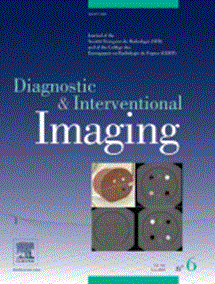Efficacy of a deep learning-based software for chest X-ray analysis in an emergency department
IF 8.1
2区 医学
Q1 RADIOLOGY, NUCLEAR MEDICINE & MEDICAL IMAGING
引用次数: 0
Abstract
Purpose
The purpose of this study was to evaluate the efficacy of a deep learning (DL)-based computer-aided detection (CAD) system for the detection of abnormalities on chest X-rays performed in an emergency department setting, where readers have access to relevant clinical information.
Materials and methods
Four hundred and four consecutive chest X-rays performed over a two-month period in patients presenting to an emergency department with respiratory symptoms were retrospectively collected. Five readers (two radiologists, three emergency physicians) with access to clinical information were asked to identify five abnormalities (i.e., consolidation, lung nodule, pleural effusion, pneumothorax, mediastinal/hilar mass) in the dataset without assistance, and then after a 2-week period, with the assistance of a DL-based CAD system. The reference standard was a chest X-ray consensus review by two experienced radiologists. Reader performances were compared between the reading sessions, and interobserver agreement was assessed using Fleiss’ kappa test.
Results
The dataset included 118 occurrences of the five abnormalities in 103 chest X-rays. The CAD system improved sensitivity for consolidation, pleural effusion, and nodule, with respective absolute differences of 8.3 % (95 % CI: 3.8–12.7; P < 0.001), 7.9 % (95 % CI: 1.7–14.1; P = 0.012), and 29.5 % (95 % CI: 19.8–38.2; P < 0.001), respectively. Specificity was greater than 89 % for all abnormalities and showed a minimal but significant decrease with DL for nodules and mediastinal/hilar masses (-1.8 % [95 % CI: -2.7 – -0.9]; P < 0.001 and -0.8 % [95 % CI: -1.5 – -0.2]; P = 0.005). Inter-observer agreement improved with DL, with kappa values ranging from 0.40 [95 % CI: 0.37–0.43] for mediastinal/hilar mass to 0.84 [95 % CI: 0.81–0.87] for pneumothorax.
Conclusion
Our results suggest that DL-assisted reading increases the sensitivity for detecting important chest X-ray abnormalities in the emergency department, even when clinical information is available to the radiologist.
基于深度学习的胸部 X 光分析软件在急诊科的应用效果。
目的:本研究的目的是评估基于深度学习(DL)的计算机辅助检测(CAD)系统在急诊科环境中检测胸片异常的有效性,读者可以获得相关的临床信息。材料和方法:回顾性收集急诊出现呼吸道症状的患者在两个月内连续进行的144次胸部x光片。五名读者(两名放射科医生,三名急诊医生)被要求在没有帮助的情况下识别数据集中的五种异常(即实变、肺结节、胸腔积液、气胸、纵隔/肺门肿块),然后在2周后,在基于dl的CAD系统的帮助下。参考标准是由两名经验丰富的放射科医生进行的胸部x线一致审查。比较阅读会话之间的读者表现,并使用Fleiss' kappa测试评估观察者之间的一致性。结果:该数据集包括103张胸片中5种异常的118例。CAD系统提高了对实变、胸腔积液和结节的敏感性,绝对差异分别为8.3% (95% CI: 3.8-12.7;P < 0.001), 7.9% (95% ci: 1.7-14.1;P = 0.012), 29.5% (95% CI: 19.8-38.2;P < 0.001)。所有异常的特异性均大于89%,结节和纵隔/肺门肿块的DL有微小但显著的降低(- 1.8% [95% CI: -2.7 - -0.9];P < 0.001和- 0.8% [95% CI: -1.5 - -0.2];P = 0.005)。DL改善了观察者间的一致性,kappa值从纵隔/肺门肿块的0.40 [95% CI: 0.37-0.43]到气胸的0.84 [95% CI: 0.81-0.87]不等。结论:我们的研究结果表明,即使在放射科医生可以获得临床信息的情况下,dl辅助阅读也可以提高发现急诊科重要胸部x线异常的灵敏度。
本文章由计算机程序翻译,如有差异,请以英文原文为准。
求助全文
约1分钟内获得全文
求助全文
来源期刊

Diagnostic and Interventional Imaging
Medicine-Radiology, Nuclear Medicine and Imaging
CiteScore
8.50
自引率
29.10%
发文量
126
审稿时长
11 days
期刊介绍:
Diagnostic and Interventional Imaging accepts publications originating from any part of the world based only on their scientific merit. The Journal focuses on illustrated articles with great iconographic topics and aims at aiding sharpening clinical decision-making skills as well as following high research topics. All articles are published in English.
Diagnostic and Interventional Imaging publishes editorials, technical notes, letters, original and review articles on abdominal, breast, cancer, cardiac, emergency, forensic medicine, head and neck, musculoskeletal, gastrointestinal, genitourinary, interventional, obstetric, pediatric, thoracic and vascular imaging, neuroradiology, nuclear medicine, as well as contrast material, computer developments, health policies and practice, and medical physics relevant to imaging.
 求助内容:
求助内容: 应助结果提醒方式:
应助结果提醒方式:


